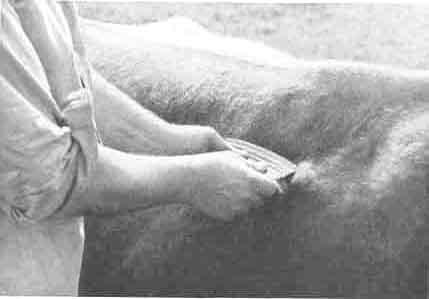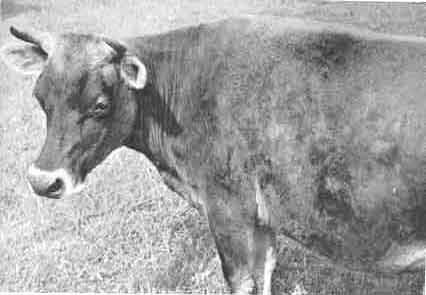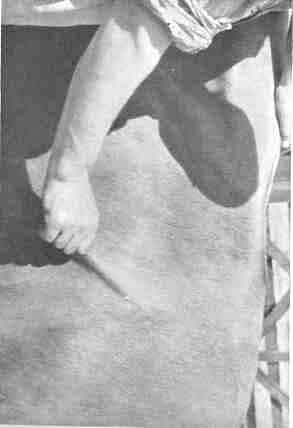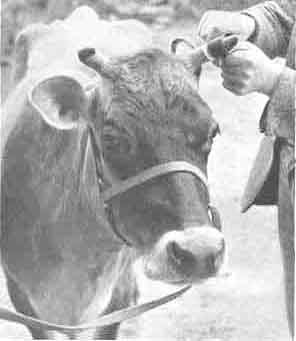
Chapter 8
PREPARING THE HEIFER AND COW
FOR LACTATION
Tremendous publicity has been given to 'steaming up' or feeding high-protein milk-stimulating foods which often have the effect, and indeed are advocated for the very purpose, of bringing a heifer to her milk before she calves. This practice, known as steaming up and pre-milking, presents the intelligent herdsman with a very big and puzzling problem. For no thoughtful person can consider such a practice as in any way likely to benefit the heifer. Many dairy farmers have nevertheless been attracted by the prospect of one or two hundred more gallons of milk (the increased yield claimed by its originators for the system of steaming up and pre-milking) and have done everything possible to encourage by feeding, udder massage, and even by hormone injections (though this is not officially advocated) to get heifers to milk before calving.
I suppose orthodox dairy farming has been developed so far along unnatural lines that I shall be considered merely reactionary and pig-headed if I condemn this practice on grounds of its unnatural-ness. The whole process of milk production, as indeed farming of any kind, is patently unnatural. But unless it is artificial insemination, which is no doubt still the supreme abomination of man's relationship with animals, there is no practice which I would condemn more. For whereas practically all other farming operations, except the use of chemicals and poison sprays, are in line with nature or in co-operation with nature and at worst a mere deviation of a natural process, the stimulation of milk secretion before the act of parturition, is a direct reversal of a natural process. In nature a mammal, whether cow, elephant or the farmer's wife, produces milk after, and more important because of, the act of giving birth. To cause the milk to flow before the calf is born is to put nature into reverse with consequences which, like those which may follow artificial insemination, cannot be estimated in advance.
Some of the consequences of steaming-up and pre-milking have nevertheless already shown themselves, to the everlasting sorrow of the farmers who were gullible enough or mercenary enough to try the system. Would that the physical suffering involved had been the lot of the originators of the system and not the animals! But I have seen and heard of many heifers which have been steamed-up, pre-milked and admittedly produced phenomenal yields of milk during the early weeks of the lactation following calving, but which have had serious mastitis and might as well have been allowed a normal calving and a normal yield and come through to the end with healthy udders for all the ultimate gain has proved to be.
One large herd of pedigree Jerseys, which I advised, is typical of many such examples of rushing into this system which the loud trumpets of enthusiasm proclaimed before it had been proved by the measured results of time and wisdom. The owner wrote saying that because the advice to steam-up and pre-milk had come from semi-official sources—a well-known agricultural college and some district advisers of the National Agricultural Advisory Service, he assumed that the method was scientifically sound and well proven by long testing to be harmless, and he adopted it in his herd without further investigation. After all, he said, our colleges and ministry scientists exist to do the investigation and pass to the farmer that information and guidance which is proved to be foolproof and profitable to the farmer, and to keep reasonably quiet about new theories especially unnatural ones, which are still the subject of experiment. Admittedly he got the big yields—some Jersey heifers yielding 2 gallons of milk a day before calving and going up to 6 gallons on calving—but every one of them went down with mastitis or acetonaemia or both before the lactation had progressed very far. When I was called in he had a shed half full of formerly highly valuable heifers all wrong in one or more quarters. These heifers had started off yielding heavily but had given a total lactation yield far less than would have been given had they been fed normally and allowed to come to their milk at the time of, instead of some weeks before, calving. Fortunately we cured most of them by the mastitis treatment I have described on page 127, and prevented further trouble by following the methods of management advocated in this book and my book, Fertility Farming, But that farmer, along with many who did likewise, cursed the day he ever heard of those unproven theories.

19. Winter coat as it begins to shed in the spring. Polden Dreaming Dorothy

20. Rubbing off the winter hair—see plate 22 for finished effect

21. Polishing the horns with emery paper

22. A fine loose skin, showing the finished effect after removing winter hair
Fortunately, though it has received no publicity of the kind that was accorded the harmful theories of steaming-up and pre-milking, the originators of this practice appear to have modified it somewhat and now I believe advocate milking a heifer before she calves only to relieve her, instead of advising the actual encouragement of milk secretion before calving. This of course is sheer common sense. If, on the rare occasions that a heifer is seen to be uncomfortable as a result of coming to her milk before calving, then it is obvious that she must be relieved. But only when, through circumstances beyond human control, the milk comes before the calf, should it be drawn other than at the normal after-calving stage. To milk a heifer deliberately and regularly, and to give her food which stimulates milk secretion, for the sole purpose of extracting milk prematurely, as was until recently urged by some authorities, can bring only disaster to our cattle and consequently lead the owners of these cattle into difficulties from which neither the Minister of Agriculture nor his officials will have the inclination, let alone the ability, to extricate them.
But the fact that I deplore steaming-up (which really means overfeeding with over-stimulating concentrates) and pre-milking, does not mean that I would not have my heifers in really good condition at the time of calving, nor that I would leave a heifer which prematurely secretes her milk, unrelieved (as I have already explained). Heifers can, however, be brought to first class calving and milking condition on herbal leys in summer and silage in winter, without any concentrates whatever. And the ultimate health and economical milk production of the future cow, in my experience, demands entirely natural and mainly bulky low-protein food up to the time of second calving. Animals so fed are far more likely to put up good life-time yields—and cost their owners nothing in veterinary bills—than those fed on concentrates during heifer-hood (i.e. the in-calf and milking heifer period of their lives).
The feeding of a dry cow does involve a rather higher level of nutrition for she will have lost a good deal of flesh during the completed lactation. But again, I am convinced that overfeeding with high-protein foods, including leys close to the time of calving, is a primary cause of milk fever and acetonaemia (see pages 114 and 128). So that while I bring the dry cow to a good condition by about the third week before calving, all concentrates, even home-grown cereals, are cut out for at least the two weeks immediately before calving. If the cow is on lush pasture or ley, this, too, is severely rationed. A complete fast is given on the day before, the day of, and the day after calving, giving during that time water only. This, together with the adequate supply of herbs in the grazing and the addition, if possible, of seaweed as manure via the soil, or as powder or meal via the mouth, is a sure safeguard against milk fever.
Perhaps the greatest mistake of all in cow feeding is to give large quantities of high protein food a week or two before and after calving, in the hope that more milk will be produced. This is a firm invitation for the cow to get indigestion at best, and at worst acetonaemia or milk fever.
The time to prepare for the next lactation in improving the condition of the cow, is three months before she calves—in drying her off for at least two months' rest, and feeding her reasonably well over the whole period of the rest—except the last two weeks before calving. Neglect to maintain the cow's condition during her dry period cannot be made up three weeks or so before she calves again.
Drying-Off a Cow in Milk
All kinds of involved methods of drying off a cow in milk have been written about, talked about and tried, from sterilizing the udder and teats, injecting penicillin into each quarter and sealing up with collodian, to merely shirking it altogether and milking the cow right through without rest. But the obvious way to stop a cow giving milk is to stop milking her and quite simply that is how I dry a cow off. If a cow is not milked she will stop making milk. Milk production continues in nature only as a result of the continuing stimulation of the suckling young. If suckling ceases milk secretion ceases without harm to the cow. Similarly assuming the udder is healthy as it will be in an organically fed herd, no harm will come to the cow, however much milk she is giving, if milking stops quite abruptly without any gradual reduction in the frequency of milking. And, once you accept my now oft demonstrated theory that mastitis arises inherently and not primarily as a result of external bacterial infection, you will realize the utter futility of disinfecting the udder, injecting penicillin, or sealing each quarter with collodian.
Of course, if the cow is giving much more than say three gallons of milk a day, it is probably more convenient and economical to let her milk through continuously and serve her rather later during the next lactation to allow a longer rest—three to four months—before a subsequent calf.
There is no need to be foolhardy in risking udder trouble, especially if the cow has not got a generation or two of 'fertility farming' in her ancestry as well as her own life. So, two days after milking has been
stopped, and again at intervals of two or three days for a week or ten days, examine her udder, draw a few drops of milk from each quarter and make sure that there is no inflammation. On the second day and for the first week or so after stopping milking, the udder may appear to be slightly distended. But it is unlikely to reach the point of discomfort to the cow at this stage of the lactation. Once the udder is completely filled, little or no more milk will be produced by the system.
It is well to withhold completely all food for forty-eight hours, if convenient, before milking is stopped. This will speed the cessation of milk secretion and at the same time benefit the general health of the cow. Let her have limited water during this fast—three or four gallons a day.
NEXT